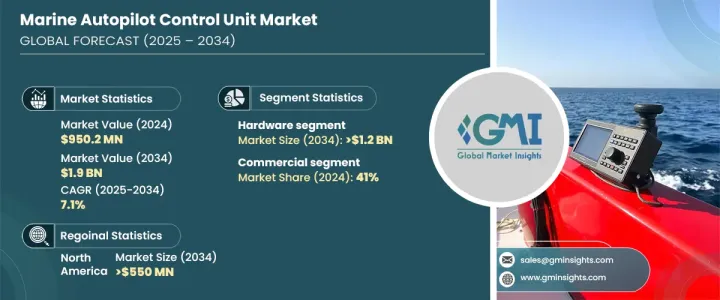
세계의 선박 오토파일럿 제어 유닛 시장은 2024년에 9억 5,020만 달러로 평가되었고, 2025년부터 2034년까지의 CAGR은 7.1%로 나타낼 전망입니다.
첨단 항법 및 자동화 기술에 대한 수요 증가가 시장 확대를 주도하고 있습니다. 해양 산업이 혁신을 수용함에 따라 정확하고 안정적이며 효율적인 제어 시스템에 대한 필요성이 그 어느 때보다 중요해졌습니다. 선박 오토파일럿 제어 유닛은 운항 안전과 연료 효율성을 향상시킬 뿐만 아니라 수동 개입의 필요성을 크게 줄여주며, 이는 채택이 증가하는 주요 요인입니다.

인공 지능(AI), 사물 인터넷(IoT), 자율 항법과 같은 기술은 이러한 시스템에 필수적인 요소로 자리 잡으며 탁월한 수준의 정밀도와 최적화를 제공하고 있습니다. 또한 전 세계 무역량이 증가하고 방위 산업이 현대화됨에 따라 해양 오토파일럿 시스템 시장도 계속 확대되고 있습니다. 또한 레저용 보트의 급증으로 보트 소유자들이 항해 경험을 향상시킬 수 있는 혁신적이고 스마트한 솔루션을 점점 더 많이 찾으면서 이러한 수요를 촉진하고 있습니다.
| 시장 범위 | |
|---|---|
| 시작 연도 | 2024년 |
| 예측 연도 | 2025-2034년 |
| 시작 금액 | 9억 5,020만 달러 |
| 예측 금액 | 19억 달러 |
| CAGR | 7.1% |
시장은 주로 구성 요소별로 하드웨어와 소프트웨어로 나뉘며, 2024년에는 하드웨어 부문이 64%의 시장 점유율을 차지할 것으로 예상됩니다. 고정밀 GPS, 자이로스코프, 가속도계와 통합된 더욱 정교한 센서, 제어 장치, 액추에이터가 표준이 되고 있습니다.
선박 유형에 따라 시장은 상업용, 방위용, 레저용, 자율/무인 선박으로 분류됩니다. 첨단 오토파일럿 시스템은 지속 가능성 표준과 규제 요건을 준수하면서 경로를 최적화하고 연료를 절약하며 실시간 모니터링을 가능하게 합니다.
북미는 2024년에 선박 오토파일럿 제어 유닛 시장에서 32%의 점유율을 차지했으며, 2034년에는 5억 5,000만 달러에 이를 것으로 예상되고 있습니다. 안전 및 연료 효율성에 대한 엄격한 규제와 함께 자율운항 선박에 대한 미국의 노력은 업계의 혁신을 촉진하고 있습니다.
The Global Marine Autopilot Control Unit Market, valued at USD 950.2 million in 2024, is set to experience robust growth with a projected CAGR of 7.1% from 2025 to 2034. The increasing demand for advanced navigation and automation technologies is driving market expansion. As the maritime industry embraces innovation, the need for precise, reliable, and efficient control systems has never been more critical. Marine autopilot control units not only enhance operational safety and fuel efficiency but also significantly reduce the need for manual intervention, which is a key factor in their rising adoption.

Technologies such as artificial intelligence (AI), the Internet of Things (IoT), and autonomous navigation are becoming integral to these systems, offering unmatched levels of precision and optimization. Additionally, as global trade volumes rise and defense sectors modernize, the market for marine autopilot systems continues to expand. The surge in recreational boating also fuels this demand as boat owners increasingly seek innovative, smart solutions to elevate their navigation experience. This growth reflects a broad transformation across multiple sectors, with marine autopilot systems playing a pivotal role in achieving higher efficiency and safety standards across the globe.
| Market Scope | |
|---|---|
| Start Year | 2024 |
| Forecast Year | 2025-2034 |
| Start Value | $950.2 Million |
| Forecast Value | $1.9 Billion |
| CAGR | 7.1% |
The market is primarily segmented by component into hardware and software, with the hardware segment commanding 64% of the market share in 2024. By 2034, this segment is expected to exceed USD 1.2 billion. A shift toward compact, energy-efficient components is driving significant advancements in the hardware sector. More sophisticated sensors, control units, and actuators integrated with high-precision GPS, gyroscopes, and accelerometers, are becoming standard. These innovations are pivotal in enhancing system accuracy, ensuring reliability, and optimizing energy use. Additionally, the demand for ruggedized hardware that can withstand the harsh conditions of marine environments is pushing manufacturers to develop durable solutions capable of lasting longer and performing consistently.
In terms of vessel types, the market is categorized into commercial, defense, recreational, and autonomous/unmanned vessels. The commercial sector, which represented 41% of the market share in 2024, is seeing significant investments in automation to enhance operational efficiency and minimize human error. Advanced autopilot systems help optimize routes, save fuel, and enable real-time monitoring, all while adhering to sustainability standards and regulatory requirements. This is driving the adoption of marine autopilot systems across the sector, ensuring better performance and safety while improving environmental impact.
North America accounted for a 32% share of the marine autopilot control unit market in 2024, with projections reaching USD 550 million by 2034. The U.S. has emerged as a leader in the integration of advanced autopilot systems, particularly in commercial and recreational vessels. The country's commitment to autonomous shipping, coupled with stringent regulations for safety and fuel efficiency, is fostering innovation in the industry. The increasing popularity of recreational boating, alongside the adoption of smart navigation technologies, is further bolstering demand for high-performance systems across diverse types of vessels.